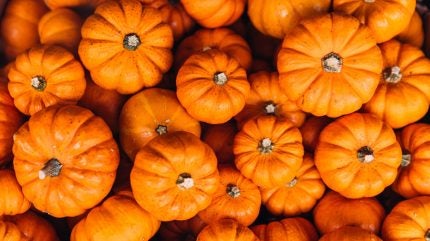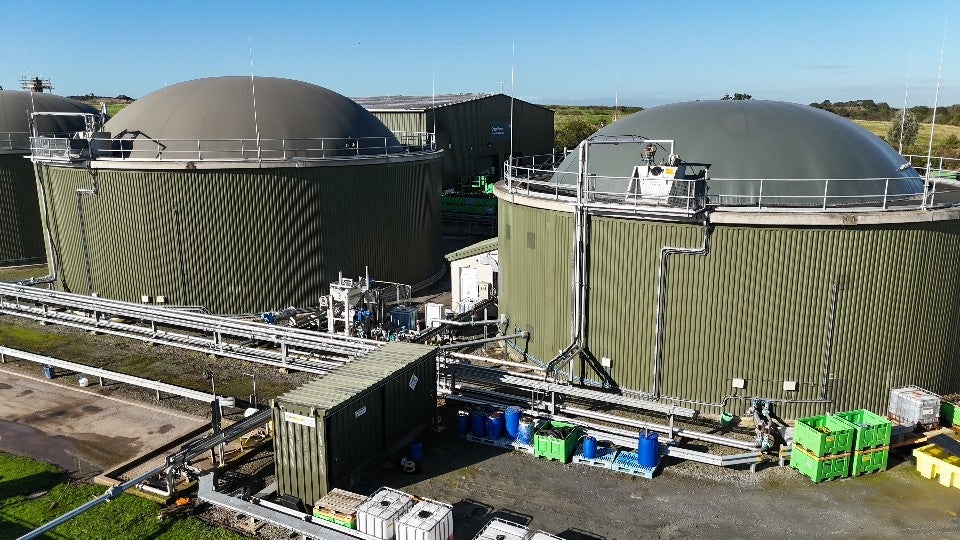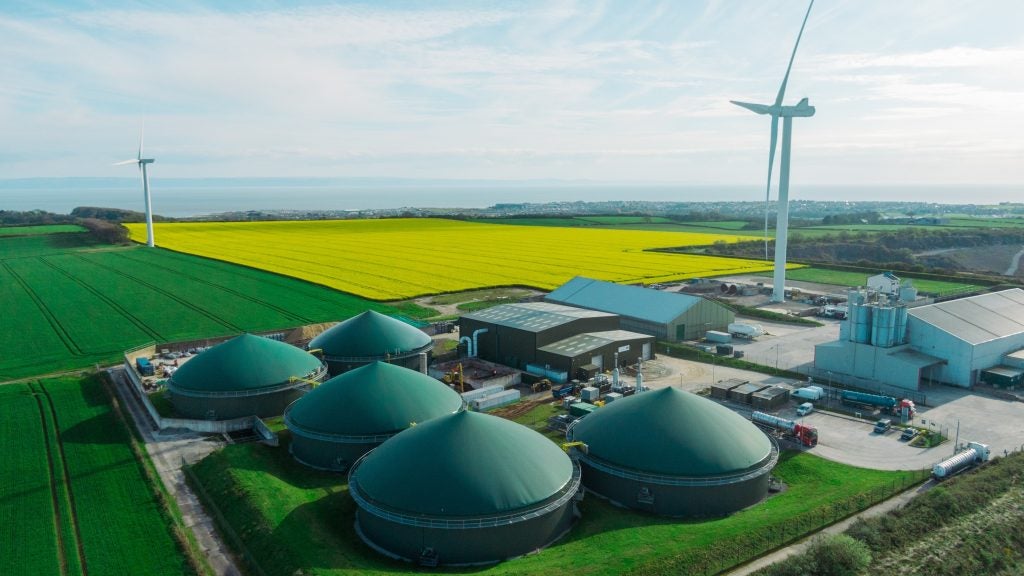
Seasonal celebrations cause spikes in certain food waste, which can either rot in landfill or be fed as a slurry to the microorganisms responsible for producing biogas through anaerobic digestion (AD). However, microbes are picky, and efficient AD requires a balanced diet.
This presents a challenge to the producers of biogas and biomethane, who prepare for a sudden influx of carbohydrate-heavy pumpkin waste in October and a spike in general food waste at Christmas.

Discover B2B Marketing That Performs
Combine business intelligence and editorial excellence to reach engaged professionals across 36 leading media platforms.
In landfill, the un-trapped gases produced by decomposing food go into the atmosphere, contributing between 8% and 10% of annual global greenhouse gas emissions. Environmental charity Hubbub tells Offshore Technology that “between 15 and 22 million pumpkins are bought, carved and thrown away uneaten in the UK annually”, eventually rotting in landfill and releasing methane, a potent greenhouse gas.
But when collected, seasonal waste can contribute to the growing role of bioenergy, which reportedly generated 14% of the UK’s total electricity in 2024. This represents a bilateral solution: meeting growing grid demands and reducing hefty food waste emissions.
Halloween thus represents either significant pollution or power potential, depending on the disposal of millions of pumpkins.
Picky microorganisms: not all foods are equal
Microorganisms break down biomatter through AD (meaning without oxygen) to produce biogas, which is usually comprises 50%-70% methane and 30%-50% CO₂. To create biomethane, the CO₂ is stripped out, leaving a gas above 95% methane.

US Tariffs are shifting - will you react or anticipate?
Don’t let policy changes catch you off guard. Stay proactive with real-time data and expert analysis.
By GlobalDataAll biomatter will decompose through AD to produce methane and CO₂, but not all feedstock is equal. Insects and microorganisms used in the processing of waste require a varied diet and, similar to humans, express preferences. Dr Cynthia Okoro-Shekwaga, biotechnology and biological sciences research council discovery fellow at the University of Leeds, explains that microorganisms “react differently [to different types of waste] because different food provides different nutrients in different quantities”.
She explains that microorganisms respond well to high-protein feedstocks: “Generally, food types that have higher protein tend to have more yield. If you have high protein and high carbohydrate foods, then it’s about finding a balance.
“You can also add fatty foods, but these can be a problem because, after a while, they to form a scum and then it is a problem to manage. But any food can be used.”
Tom Hall, chief commercial officer at the UK’s largest biogas producer, Bio Capital, tells Offshore Technology: “Typically, high-energy foods produce the most methane per kilogram such as fats or oils (but these can cause process imbalances if overused), sugary foods (fruits, sweets, syrups), starchy foods (bread, pasta, rice, potatoes) and protein-rich foods (meat scraps, dairy products, legumes). A digester runs best like a stomach and thrives on a good balanced diet.”
The sensitivity of the microorganisms in the closed drum of AD facilities means that any change can have a significant effect on biogas yield. Biogas and biomethane producers must be prepared for fluctuations in feedstock which affect the quantity and composition of resource flow through the biogas system, including variations in feedstock.

Adapting biogas production to seasonal biomatter
Pumpkins are primarily carbohydrate, which is an important part of a balanced biogas feedstock, but a sudden influx of the seasonal icons could disrupt the anaerobic digestion of the microorganisms busily producing gas in the drum. For optimal biogas production, Okoro-Shekwaga explains that pumpkin waste must be broken down and mixed up into existing systems.
“You cannot define your system just to run on pumpkins, so the big issue is variability,” she says.
“We characterise seasonal foods to understand their content and see in what proportions we can mix them into existing systems. You wouldn’t set up a system wholly to run on seasonal plants because it wouldn’t be sustainable.”
Feedstock is characterised to analyse organic content, nutritional makeup and moisture level, so that biogas production can be optimised. A balanced carbon-to-nitrogen ratio is crucial for the microbes to work efficiently while pH levels must be carefully managed depending on the stage of digestion. Early stages benefit from lower pH levels, but methanogenic bacteria (responsible for the final of the four stages of AD) are most efficient if the pH ranges between 6.8 and 7.2.
By characterising the foods that arrive at biogas facilities, researchers can manage the delicate balance required for picky microorganisms.
Last year, Severn Trent Green Power (STGP) processed around 100,000 pumpkins across ten food waste AD facilities. The company recycles 25% of household food waste in England and Wales and around 12% of commercially collected food waste.
Speaking to Offshore Technology, STGP’s strategy and business development lead Farryad Ishaq explains that the issue is less quantity and more composition.
He says: “Pumpkins after Halloween might seem like they would also boost our intake, but in reality, they don’t create much of a spike in deliveries. The key thing we focus on around Halloween is the variety of food waste being processed. A diverse mix is essential for producing high-quality biogas. We make sure to balance pumpkin waste with other types of food waste, so the digestion system doesn’t ‘overdose’ on pumpkin, so to speak.”
AD facilities also experience a massive increase of food waste around Christmas. STGP notes that around 4,000 tonnes (t) of mince pies are disposed of uneaten at Christmas, as well as 2,000t of cheese and 3,150t of Christmas dinner ingredients – the latter alone able to produce enough biogas to cook another 85,000 turkeys.

Biogas in the UK: government support and looming challenges
Biogas is a growing sector in the UK; in 2023, the AD and Bioresources Association reported that there were 756 operational AD plants in the UK in December 2024, up from the 730 reported in 2023. More broadly, Europe currently leads in capacity and production globally with around 20,000 biogas plants, led by Germany, which has the highest annual biogas production at around 87TWh a year.
Hall comments that “the AD sector is well established in the UK but is far from reaching its full potential”, for which “government support is key”.
He cites as an example the country’s main bioenergy support mechanism the Green Gas Support Scheme (GGSS), which provides regular payments to producers based on the volume of biomethane injected into the grid. However, the scheme is finite, and Hall says that “clarity on what happens next is needed as soon as possible to prevent companies delaying investment decisions”.
He adds: “Overall though, signs from government are very positive, and biomethane is recognised as having a crucial role in the UK’s energy transition, with positive messages coming from the recent Labour Party conference.”
Recent legislation reinforces this optimism. As of 31 March 2025, UK businesses are now required to separate food waste to enable collection (although businesses with fewer than ten employees have until 2027). From 31 March 2026, the legislation will also apply to households. However, this process will take some time to fully implement, as 31 local authorities have long-term waste disposal contracts and have transitional relief pushing back the timescale. In the case of North Yorkshire Council, its contractual obligations mean the implementation is delayed until February 2043.
Changes in food waste collection will simplify the process of acquiring feedstock, but Okoro-Shekwaga notes that collection is a two-horned beast: “The first problem is sorting out source. It is difficult to only collect food waste, because it is always mixed with so many other things. People put their food, paper and everything in the bin together.”
She adds that without proper collection, a second issue arises: “If you have plastic and other materials going into the system, it starts to take up volume and eventually interact with the microbial activities.
“Microbes like to have a slurry-like environment so they can swim along, but if there are blockades in the system then they cannot move freely and that reduces the efficiency of the system.”
Part of the solution, according to local councils and Hubbub, is education. The charity runs its #EatYourPumpkin campaign annually to try to tackle food waste, telling Offshore Technology that “seasonal events like Halloween are a high-profile, fun opportunity to put food waste in the spotlight and empower people to act”.
Its message is increasingly echoed by local governments concerned about driving down food waste, including the Colchester City Council and Eastleigh Borough Council, which recently distributed messages about collecting pumpkins over the seasonal period, to be fed into AD facilities for biogas production.
Frequently asked questions
-
What is biogas and how is it produced?
Biogas is a renewable fuel, which is a mixture of methane, CO2 and small amounts of other gases, such as hydrogen sulphide, nitrogen and water vapor. It is generated through the anaerobic digestion of organic matter by bacteria, which break down biomass fed into a closed drum system. Feedstocks include crops or organic waste, such as animal or food waste.
-
What is the difference between biogas and biomethane?
Biogas is a mixture of methane (50-70%), CO2 (30-50%) and trace gases. It usually contains impurities and is usually used in smaller-scale applications, such as heating and electricity generation in localised settings. Biomethane is refined biogas. CO2 is removed until the gas is almost pure methane. Biomethane has the same properties as natural gas, so can be injected directly into the national grid or used as a vehicle fuel.
-
How is biogas used to provide energy?
Biogas can be directly converted into electricity and heat through combined heat and power (CHP) plants , which use combustion engines, fuel cells or gas turbines to generate electricity. If refined and upgraded to become biomethane, it can be compressed or liquefied to use as a vehicle fuel, offering a cleaner alternative to fossil fuels.
-
How does anaerobic digestion work?
Anaerobic digestion occurs in the absence of oxygen, in a closed drum. It occurs in four stages: hydrolysis, acidogenesis, acetogenesis and methanogenesis. During hydrolysis, complex organic molecules are broken down into simpler sugars and amino acids; in acidogenesis, these are converted into volatile fatty acids and hydrogen; in acetogenesis, these are converted into acetic acid, along with additional hydrogen and carbon dioxide; in methanogenesis, methanogenic microorganisms convert acetic acid and hydrogen into methane and carbon dioxide, resulting in the production of biogas.
-
What are the biggest challenges to biogas production?
The biogas sector is facing high capital costs for new plants, as well as limited availability of sustainable feedstocks and complications with collecting organic waste at scale. There are also regulatory uncertainties and social obstacles, with biogas see as an unsanitary energy source by some parts of the general public.






